Cardiotoxic Effects of Lachesis acrochorda Snake Venom in Anesthetized Wistar Rats
- PMID: 39330835
- PMCID: PMC11436055
- DOI: 10.3390/toxins16090377
Cardiotoxic Effects of Lachesis acrochorda Snake Venom in Anesthetized Wistar Rats
Abstract
Ophidism is a public health problem in tropical countries, occurring predominantly in rural areas. In Colombia, among the species responsible for snakebite envenomation, inflicting high mortality, is the Chocoan bushmaster, Lachesis acrochorda, better known locally by the names "verrugosa (warty)" and "pudridora (rot-causing)". In this research, the cardiotoxic effect of the venom of L. acrochorda in male Wistar rats weighing 230 ± 20 g was evaluated. A statistical design of randomized blocks was implemented with three treated groups, injected with lyophilized venom (doses of 3.22 μg/g, 6.43 μg/g, 12.86 μg/g), and a control group injected with 0.9% saline solution. Electrocardiographic (ECG) recordings were taken from the anesthetized animals, revealing an increase in the amplitude of the P and T waves and an increase in the duration of the QT intervals in the electrocardiographic recordings. These increases were not observed in the control biomodels. In the analysis of the CK and CK-MB enzyme levels, increases were also observed in the levels of cardiac isoenzymes in the injected animals, but none in the control animals. The histopathological analyses carried out reveal that the injected animals showed effects such as interfibrillar and perivascular edema, cellular shortening of the cardiomyocytes, foci with tissue destructuring, and necrosis with contraction bands. In conclusion, the venom of the Lachesis acrochorda snake increases the P and T waves and the QT interval and increases the CK and CK-MB enzymes in the blood. Additionally, it causes interfibrillar and perivascular edema in the cardiac tissue, cardiocytolysis, and contraction bands.
Keywords: Lachesis acrochorda; Rattus norvegicus; cardiotoxic; snake venom.
Conflict of interest statement
The authors declare no conflicts of interest.
Figures
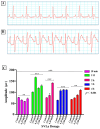
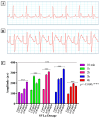
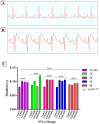

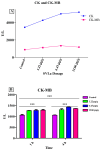
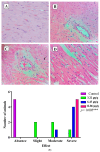
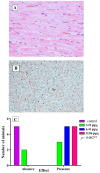
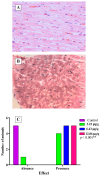
Similar articles
-
Proteomic and functional analyses of Lachesis acrochorda snake venom from the Valle del Cauca Department of Colombia.Acta Trop. 2023 May;241:106895. doi: 10.1016/j.actatropica.2023.106895. Epub 2023 Mar 15. Acta Trop. 2023. PMID: 36931336
-
Hemodynamic responses to Lachesis muta (South American bushmaster) snake venom in anesthetized rats.Toxicon. 2016 Dec 1;123:1-14. doi: 10.1016/j.toxicon.2016.10.001. Epub 2016 Oct 5. Toxicon. 2016. PMID: 27720763
-
The Colombian bushmasters Lachesis acrochorda (García, 1896) and Lachesis muta (Linnaeus, 1766): Snake species, venoms, envenomation, and its management.Toxicon. 2023 Jul;230:107152. doi: 10.1016/j.toxicon.2023.107152. Epub 2023 May 11. Toxicon. 2023. PMID: 37178796 Review.
-
Snake venomics across genus Lachesis. Ontogenetic changes in the venom composition of Lachesis stenophrys and comparative proteomics of the venoms of adult Lachesis melanocephala and Lachesis acrochorda.J Proteomics. 2012 Dec 21;77:280-97. doi: 10.1016/j.jprot.2012.09.003. Epub 2012 Sep 12. J Proteomics. 2012. PMID: 22982523
-
VENOMOUS SNAKEBITES IN CROATIA, CLINICAL PRESENTATION, DIAGNOSIS AND TREATMENT.Acta Clin Croat. 2022 Jun;61(Suppl 1):59-66. doi: 10.20471/acc.2022.61.s1.10. Acta Clin Croat. 2022. PMID: 36304803 Free PMC article. Review.
Cited by
-
Takotsubo cardiomyopathy associated with Protobothrops mucrosquamatus envenomation: a case report.Front Cardiovasc Med. 2025 Jun 3;12:1598373. doi: 10.3389/fcvm.2025.1598373. eCollection 2025. Front Cardiovasc Med. 2025. PMID: 40529557 Free PMC article.
References
-
- Angel-Camilo K.L., Guerrero-Vargas J.A., Carvalho E.F.d., Lima-Silva K., de Siqueira R.J.B., Freitas L.B.N., de Sousa J.A.C., Mota M.R.L., dos Santos A.A., da C. Neves-Ferreira A.G., et al. Disorders on Cardiovascular Parameters in Rats and in Human Blood Cells Caused by Lachesis Acrochorda Snake Venom. Toxicon. 2020;184:180–191. doi: 10.1016/j.toxicon.2020.06.009. - DOI - PubMed
-
- Cardoso J.L.C., França F.O.S., Wen F.H., Málaque C.M.S., Haddad V., Jr. Animais Peçonhentos No Brasil: Biologia, Clínica e Terapêutica Dos Acidentes. Rev. Inst. Med. Trop. Sao Paulo. 2003;45:S87. doi: 10.1590/S0036-46652003000600009. - DOI
Publication types
MeSH terms
Substances
Grants and funding
LinkOut - more resources
Full Text Sources
Research Materials
Miscellaneous

